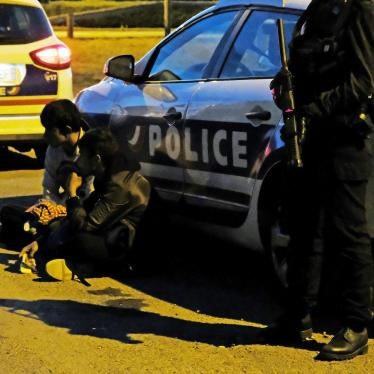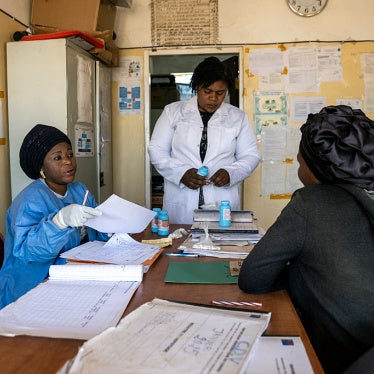Imagine the Hollywood blockbuster about one boat’s perilous journey in the Mediterranean. The Eritrean mother with her five-year-old son, the 16-year-old Afghan boy traveling on his own, and the Syrian patriarch with his entire family — they would be the heroes. We would learn through flashbacks the horrors they are fleeing, and see their humanity as they defend themselves and others against a villainous smuggler whom they were forced to turn to as the only way to reach safety. But the film’s main bad guys would be the European Union leaders who bicker behind closed doors about who should go rescue the migrants as their boat sinks, and who will have to bring them to shore and offer them refuge. It would be one helluva movie — if it weren’t already a hellish reality.
So far this year, at least 1,750 people have died in the Mediterranean trying to reach European shores on unseaworthy, overcrowded boats. More than 1,000 people died in a single week in April, making it the deadliest month on record on the world’s most dangerous migration route.
With the world watching, EU heads of state last week gathered in an extraordinary summit to address the crisis. United Nations Secretary General Ban Ki-moon, U.N. High Commissioner for Human Rights Zeid Ra’ad Al Hussein, and Pope Francis are among the world figures who had called on EU leaders to adopt a comprehensive, rights-based approach. What was needed was a genuine, EU-wide commitment to save lives at sea, create safe and legal migration channels, and share responsibilities for protecting people fleeing war and persecution in their home countries. What was delivered instead was a set of policy proposals driven by a desire to prevent migrants and asylum seekers from ever reaching EU shores.
EU leaders responded to immediate humanitarian needs and committed to beefing up patrols in the Mediterranean (with critical details about areas of deployment and mandate yet to be worked out). However, the majority of the proposals reflected the EU’s intense focus on securing its borders. And they did little to debunk four false premises that underpin the irrational and irresponsible debate around immigration and asylum in Europe.
False Premise #1: Active search and rescue serves as a pull-factor. After more than 360 people died in a single shipwreck off the coast of Lampedusa in October 2013, Italy began a massive naval operation called Mare Nostrum, the sole purpose of which was humanitarian search and rescue. Deployed in territorial and international waters, Italian naval ships actively searched for migrant boats. The mission is credited with saving tens of thousands of lives. Instead of sharing responsibility for rescue efforts, however, other EU member states criticized Italy for encouraging boat migration. Italy concluded Mare Nostrum in November 2014, when the EU began a far more limited operation under the aegis of its external borders agency, Frontex.
But thousands of people continued to make the journey even after the end of Mare Nostrum and even through the winter months under adverse weather conditions. Half of those who have arrived by sea so far in 2015 are from refugee-producing countries: Syria, Eritrea, Somalia, and Afghanistan. Many of those coming from other major sending countries — Nigeria, The Gambia, Senegal, Mali — are economic migrants seeking to improve their lives. Determination, desperation, courage, and opportunity determine the numbers of those willing to risk the journey, not certainty of rescue.
Last week, EU leaders pledged to triple the budget of Frontex patrols in the Mediterranean, and 15 out of 28 member states, including the United Kingdom and Germany, offered ships to increase the number of vessels out at sea. This is a step in the right direction, but to be effective in saving as many lives as possible, the Frontex missions — Triton and Poseidon — should be deployed in international waters with a clear mandate to actively seek out migrant boats.
False premise #2: The real problem is criminal networks. EU leaders pledged to “disrupt trafficking networks” and “undertake systematic efforts to identify, capture and destroy vessels before they are used by traffickers.” This focus on traffickers, however, is disingenuous and misleading. Most of those on the boats are not trafficking victims, but rather migrants and asylum seekers who have paid smugglers because they have no other options to reach the EU; they get on “death boats” fully aware of the risks.
It is as yet unclear how this disruption aspect of the EU plan will be carried out. Most of the boats leave from Libya, which has experienced a total breakdown in governance and rule of law. There are competing authorities and generalized violence, and various, mostly armed factions control different parts of the Libyan coastline. Many questions remain unanswered: Who under EU authority will do the destroying of vessels, how, and based on what intelligence? Information coming out of Libya is questionable. How will these operations respect the lives and safety of migrants and asylum seekers?
False premise #3: The best way to prevent deaths at sea is to prevent departures. Often, this argument is couched in humanitarian terms, but the EU summit conclusions are quite forthright: The majority of the policy proposals are geared toward “preventing illegal migration flows.” Measures include strengthening immigration cooperation with countries such as Tunisia, Egypt, Sudan, Mali, and Niger and working with unspecified countries to improve maritime border control and search-and-rescue capacity; more readmission agreements to facilitate quick returns to countries of origin and transit; and rapid return of irregular migrants from “front-line” EU states such as Italy, Malta, and Greece.
All coastal countries have search-and-rescue responsibilities, and EU financial and technical support to strengthen their capacity is positive. It is also good for the EU to invest in stabilization and development, if done in a way that respects human rights. But the EU will have to make sure that concrete immigration cooperation measures do not effectively trap people in abusive situations, prevent them from accessing fair asylum procedures, or send them to countries where their lives or freedoms may be at risk.
Bilateral and EU-wide readmission agreements tend to have poor human rights safeguards, involving virtually immediate returns without a meaningful opportunity to contest the decision or claim asylum. EU member countries have the right to return migrants found to have no claim to remain, but only following a fair and efficient procedure that includes an assessment of the risks a person may face upon return.
False premise #4: The EU is already overwhelmed by asylum seekers. The EU as a whole had a significant increase in asylum applications in 2014, with 626,000 new ones filed across the 28 member countries. It was the highest number since 1992. A little under a third (203,000) were filed in Germany.
These might sound like high numbers, but compare them with the responsibility shouldered by neighboring countries in crisis. Lebanon now has over one million Syrian refugees — one-fourth of the small country’s population. As the head of the U.N. refugee agency, UNHCR, pointed out recently, this is equivalent to Germany receiving 22.5 million refugees.
The real problem isn’t the numbers, but rather the unequitable distribution of asylum seekers among EU member states, and poor preparation and inadequate investment in decent and fair procedures and reception conditions. Six countries (Germany, Sweden, Italy, France, Hungary, and the U.K.) received over 75 percent of all asylum applications in 2014. But per capita, Sweden and Hungary had by far the most. France and the U.K. had 955 and 495 applicants per one million inhabitants, respectively, compared with 8, 415 applicants per one million inhabitants in Sweden. Countries such as Portugal, Slovakia, and Romania received fewer than 100 applicants per one million inhabitants, while Spain had only 120.
There are many reasons for the imbalance, including rational choices by asylum seekers to head for countries where they believe prospects are better for getting some kind of protection and proper integration measures. Despite a common EU asylum system, there is wide disparity in procedures, reception conditions, and support for recognized refugees. It’s no surprise that Italy and Greece, two of the main countries of entry into the EU, have relatively low per capita applications (1,065 and 850 applicants per one million inhabitants, respectively). Greece has made strides to fix its dysfunctional asylum system, but access to the procedure remains problematic, recognition rates are among the lowest in the EU, and asylum seekers are left to their own devices and face xenophobic violence on the streets. Italy has high recognition rates, but inadequate reception facilities and poor integration programs.
EU policy known as the Dublin Regulation imposes the general rule that asylum seekers must apply for asylum in the first country of entry into the EU. This both places an unfair share of the responsibility on countries at the EU’s external borders and creates an incentive for those countries to make their systems as unattractive as possible, encouraging onward movement.
At the summit last week, EU leaders made no real steps forward on a more equitable distribution of responsibility for asylum seekers. They made a commitment to “consider” options for emergency relocation between EU member countries on a voluntary basis. But a much-needed revision of the Dublin Regulation is not even on the table.
The European Commission, the EU’s executive body, will present a comprehensive migration plan in mid-May. To be meaningful, this plan needs to include more safe and legal channels into the EU — a key part of any long-term solution to minimize dangerous migration. The EU should make a collective commitment to increase paltry refugee resettlement quotas, issue far more humanitarian visas, and ease restrictions on family reunification. Together, these measures would help many reach the EU without having to risk their lives on rickety boats.
In the Hollywood movie, our heroes would make it to shore. They would make it to a welcoming European country, and be offered a decent place to live and a chance to rebuild their lives in dignity and security. The big question now is whether EU leaders will show the political leadership to make this fiction a reality.








